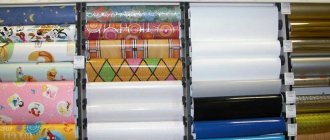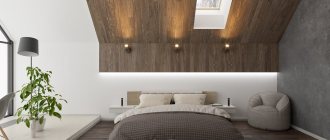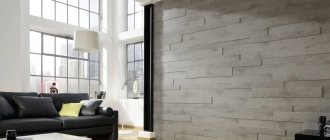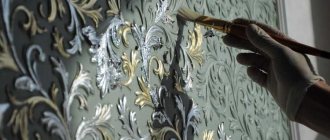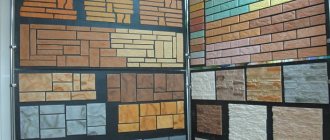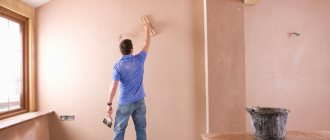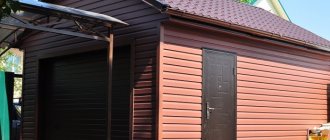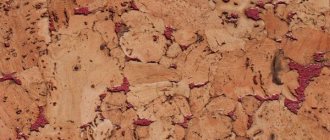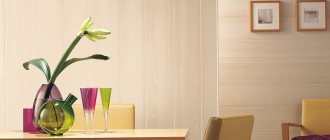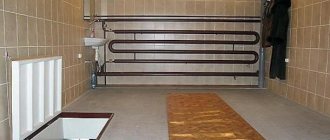Types of non-combustible wall products
Non-combustible wall products include heat-resistant plasters and mortars intended for laying heat-resistant ceramic tiles:
- terracotta;
- majolica;
- clinker tiles;
- fireclay tiles.
There are many recipes for plaster and mortar for laying ceramics.
An example of a fireplace with a firebox and a closed glass door. The presence of glazed doors, on the one hand, protects the interior from contamination by combustion products, and on the other, allows you to admire the fire.
SKL products
SCL - calcium silicate sheet - environmentally friendly material. Does not contain harmful substances and carcinogens. Retains mechanical properties - strength and hardness when heated. Contains:
- paper pulp - 10%;
- quartz powder 45%;
- cement – 40%;
- additives that increase the mechanical properties of the material – 5%.
A decorative layer with ultraviolet painting is applied to the front side of the SC sheet. The levels of fire and moisture resistance allow the use of SCL both in the external and internal decoration of buildings. This material is good for finishing rooms with high humidity - household rooms, baths, bathrooms. The ability to resist fire allows the use of SCL for finishing the walls and ceilings of rooms near the hot surfaces of the stove and fireplace.
SML products
SML - glass-magnesium sheet - is a relatively new material that has strength, flexibility, moisture and heat resistance. It includes:
- magnesium oxide – 40%;
- magnesium chloride – 35%;
- fine wood shavings – 15%;
- extruded perlite – 5%;
- additives – 4%
- fiberglass – 1%.
LSU does not have a harmful effect on the human body, therefore it is used in interior decoration. High fire resistance up to 1000°C allows it to be used as fireproof panels for interior wall decoration near heating sources and open fire.
GKLO products
GKLO is a fire-resistant plasterboard sheet. According to GOST 32614-2012, developed jointly with the Knauf company, and put into effect on the territory of the Russian Federation in 2015, this material is designated by the letter F - “fire-resistant boards”. Its fire resistance must be at least 20 minutes when exposed to open flame.
The heat resistance of gypsum plasterboard is achieved by introducing special additives into gypsum that increase the resistance of the material to high temperatures and prevent smoke from occurring in a fire. To facilitate recognition, the surface of the gypsum board is painted light pink, and the markings are done in red. Knauf Fireboard - the most fire-resistant product from Knauf - has an additional reinforcing layer of fiberglass. Used as fire-resistant cladding for walls and ceilings.
SKL panels
The calcium silicate filler gives sheets of this type high strength and low weight. The material is environmentally friendly - during operation (including when heated) it does not emit toxic substances or unpleasant odors, since it does not contain asbestos and formaldehyde. The sheets tolerate humid microclimates well, as they contain gypsum or its derivatives.
The scope of application of calcium silicate sheets is extensive. They cover walls, ceilings and floors. The material is used equally effectively for both interior and exterior decoration. It is excellent for external facade work, finishing building plinths, constructing formwork and partitions, and fire-resistant roof screens.
Absolute protection from open fire and extreme temperatures allows the use of SCL panels in metal processing shops or high-temperature industries. They are great for cladding baths and saunas or finishing fireplaces.
The panels are flexible. The bending strength of SKL is 13.5 MPa. The noise reduction level is 44 decibels, which is enough to soundproof public institutions (bars, nightclubs, recording studios). The composition of calcium silicate panels includes several antiseptic components. Thanks to this, the cladding will not be susceptible to fungus or mold.
The panels are manufactured in several configurations with different fastening systems. Manufacturers' assortment includes many models that are suitable for installation yourself and do not require professional skills. Most of the products are made with a finished finishing layer and do not require further finishing.
What panels are there?
Classification
- Non-combustible panels include materials that are incapable of ignition when exposed to open fire, and also do not ignite from sparks, electric current, as a result of a chemical reaction or high temperature. They are included in table No. 1 according to GOST 30244-94 and have a flammability group of NG according to SNIP 21-01-97.
- There are also materials that are difficult to combust. They are capable of maintaining combustion if exposed to open fire. Such materials are not capable of spontaneous combustion or ignition.
- All other materials that can ignite from fire and subsequently maintain combustion are classified as combustible.
Snip brickwork of walls and partitions: what to look for
Standards for the thickness of non-combustible sheets.
Scope of use
In the recent past, such materials were mainly used as protective screens against fires, limiting potentially dangerous areas or cutting off the combustion sector. The most popular material here is drywall. Currently, thanks to the use of modern technologies, non-combustible materials for wall decoration are produced with the highest aesthetic qualities, which are practically no different in appearance from natural, elite materials. Such as wood, cork or bamboo. (See also the article What is the best way to decorate walls in a country house.) In private houses and apartments, non-combustible finishing materials for walls are used less frequently, with the exception of kitchens or open balconies. But in cafes, offices or nightclubs this type of decoration prevails
After all, in these places there is a risk of fire and, what is also important, the fire inspector will have fewer complaints against the owners.
Non-flammable finishing of a nightclub.
The installation area directly depends on the thickness of the panel; for ceilings, sheets of 3–4 mm are used. The panel with a thickness of 5 - 8 mm can be mounted both on walls and on the ceiling. For partitions, a sheet of 6–10 mm is taken. Sheets of 10 mm or more are used for finishing floors, facades, window sills, etc. (See also the article Features of finishing the facade of a house made of aerated concrete.)
Classification of non-combustible panels
According to the degree of flammability, products can be classified as follows:
- Non-flammable. This can be called a product that ignites under the direct influence of an open flame, but will not react in any way to a spark, high temperature or a chemical reaction.
- Fire resistant. Such surface finishing panels can resist flames for a certain period of time. By themselves they do not ignite or burn.
- Flammable. These are finishing products that support combustion.
Ideally, buy fire-resistant or non-combustible materials, even though they are the most expensive. This ensures that the fire will not spread.
Fireproof or fireproof building materials
GOST 31939-2012 (iso 3251:2008) paint and varnish materials. determination of the mass fraction of non-volatile substances
What is fire retardant material?
Fire-resistant, fire-resistant or fire-resistant material
is a material that, after undergoing chemical treatment, has certain physical properties that allow such material not to ignite instantly, but to hold and prevent the expansion of fire, while naturally reducing the likelihood of a fire in the room where such material is used .
A very important issue from the point of view of arrangement for safe work and not only
The importance of creating a fireproof room cannot be overestimated. So the main negative characteristics of building materials:
- Smoke formation
- Flammability
- Flammability
- Toxicity
Also, all materials are divided into two main types, if we speak in the context of arranging a boiler room: flammable and non-flammable. We are interested in non-flammable or fire-resistant materials.
Materials used
TERRACO HANDYCOAT All-Purpose is a universal putty, a ready-to-use solution for repair work on all types of surfaces. High-quality building material is completely safe and non-toxic. It has a long shelf life, water resistance, and excellent adhesion to various substances. Does not crack for a long time, has a bright whiteness. The consistency is suitable for cleaning even the smallest cracks. The putty has a fire hazard class of KM0.
TERRACO Terramatt FR - matte water-based paint (with fire hazard class KM0.)
When used together, these materials provide an excellent non-combustible system solution for escape routes.
Putty TERRACO Handicoat (KM 0)
Paint TERRACO Terramat FR (KM 0)
Non-flammable finishing system
TYPE OF FINISH : Smooth painted walls COST : Best price in Moscow from 60 rub./m2
How fire danger is measured
Methodological materials on life safety
According to GOST standards on the fire hazard of materials, all products for construction are divided into several categories. There are only two main groups: combustible (G) and non-combustible (NG) materials. Non-combustible products (natural stone, cement, glass) do not smolder or burn, therefore they are considered as a single group. But materials from category “G” are divided into subgroups according to a number of characteristics:
- Flammability (four groups from G1 to G4);
- Speed of fire spread over the surface of the material (RP1-RP4);
- Flammability (B1-B3);
- Smoke formation (D1-D3);
- Toxicity (T1-T4).
Materials marked G4, E4, D3 and RP4 are the most dangerous in a fire - they quickly flare up and completely burn out, releasing acrid smoke and harmful toxins that can cause poisoning or death.
Sheet and slab NG materials
Sheet and slab materials can be insulators, insulation materials, non-combustible panels for interior decoration and other types of building materials. Today, the list of such products has thousands of items. Here are the most popular NG materials produced in slabs and sheets:
- Cement particle boards. This NG material is used for constructing building frames, leveling floors, constructing partitions and other purposes. They cut perfectly and are resistant not only to temperatures and fire, but also to moisture.
- Decorative wall panels FIREPROTEC YPL. Environmentally friendly panels created on the basis of gypsum particle board can be used even in preschool institutions. They are characterized by high fire safety and aesthetic parameters.
- Impact board. This is a non-flammable panel, covered on top with HPL, which belongs to the group of flame-retardant materials. The ends of the panels are also protected. The board has high aesthetic parameters, including the texture of valuable wood species. It is hygienic, fire-resistant, moisture-resistant, and environmentally friendly. It can be installed in preschool educational institutions, sports facilities, and public places.
- PVTN. These vermiculite boards can be used in hot industries, such as in a metallurgical workshop. In addition to their basic properties, they are moisture resistant and have low thermal conductivity. They are used for arranging cable routes and protecting banks and archives from fires.
- Fire-resistant GVL. This is the familiar drywall, but it has fire-resistant properties. It holds the fire for half an hour. These sheets are gray in color and easy to process.
- Fiberboards. This is a product made using wood fiber pressing technology. Cement and a special binder are added to it, which makes the slabs non-flammable and resistant to biological factors. The slabs have a two or three-layer structure. It is quite easy to cut, creates good acoustics, and is attached to structures with self-tapping screws.
- SKL panels. They are made from calcium silicate raw materials. They are light and durable, environmentally friendly. SKL are used for finishing any premises, including baths and swimming pools. They are characterized by ductility and can withstand heavy bending loads.
- Gypsum fiber sheets. NG material is made from cellulose waste paper by pressing in a semi-dry state. It has high technical and operational properties: strength, moisture resistance, ability to withstand heavy loads, low cost. They are used to line walls, make suspended ceilings, and level floors.
- Oriented strand board. It is produced from shavings and adhesive resin through high-pressure pressing. Thickness varies from 6 mm to 3 centimeters. OSB is durable; in terms of this indicator, it is 3 times higher than MDF and chipboard. With such indicators, NG material is very flexible, so it is often used for cladding bay windows, attics, verandas and gazebos. OPS is in high demand in suburban low-rise construction.
An example of installing fireproof boards before installing a stove
Non-combustible wall panels, installation work
The work is not difficult, but it requires following some instructions and recommendations. The scheme is as follows:
- Installation is carried out on the sheathing. After all, non-flammable products are almost no different from their flammable counterparts. Therefore, no special technology is needed here. The only difference is that during installation, non-combustible slabs are attached to a non-combustible sheathing. There is an option for fixing products without creating a sheathing. Then the products are attached to a perfectly flat wall using heat-resistant glue using self-tapping screws.
- You can often find the option that non-flammable panels for interior wall decoration are fixed onto profiles shaped like the letter P. They are also made of metal. Sheets of drywall are fixed using self-tapping screws, the cap is slightly recessed into the sheet and then puttied.
- As for the installation of products with a finishing layer on the surface, the use of self-tapping screws is allowed, but metal clamps are best suited. This way, hidden installation is carried out, the surface is not damaged and does not lose its decorative appeal. The guides are fixed in increments of 50–60 cm.
There are manufacturers who produce non-flammable decorative panels for walls and special aluminum guides that simplify installation.
This way you can install non-flammable panels in a house, apartment or any other room. If you have no skills in such work, then it is better to use the services of professionals. The panels will protect against unforeseen circumstances and will last for decades.
Compliance of materials with fire safety classes
It is better to purchase flooring in specialized stores or retail outlets of the manufacturer, where you can ask for a fire certificate for the flooring, which will indicate the above indicators. As we have already said, the listed set of fire safety factors were compiled into classes (CM) and below we will analyze what indicators are included in different classes and list the floor coverings corresponding to them.
- Class KM-0 is assigned to gypsum or cement mortars, since the non-combustible base for the floor covering guarantees the integrity of the building structure when exposed to fire.
- Class KM-1 is considered fireproof and corresponds to the indicators G1, V1, D1, T1, RP1. These materials include natural stone, ceramic tiles, porcelain stoneware, brick.
- Class KM-2 is low-hazard and corresponds to the indicators G1, V1, D2, T2, RP1. These materials include special non-flammable linoleum and self-leveling polymer coatings.
Linoleum is one of the oldest and most common floor coverings classified as construction and finishing materials. This material has received well-deserved recognition from both construction specialists and ordinary citizens who experience its benefits in the process of using it.
There are different approaches to classifying this flooring. Every day the linoleum manufacturing process is being improved and becomes more technologically advanced. Thanks to the use of new technologies, new collections of linoleum with a number of distinctive features and properties are emerging.
Non-flammable linoleum
One of the varieties of new generation linoleum is non-flammable linoleum of the Spetsstrol brand. This linoleum is also called fireproof. Spetsstrol is a unique development of Russian scientists, which currently has no analogues in the world. Let's try to find out what kind of coating it is, what advantages and unique properties it has.
Purpose of non-flammable linoleum
Non-flammable linoleum
Spetsstrol (most often called commercial linoleum) is a special multi-layer floor covering intended for rooms where the use of other floor coverings is unacceptable due to fire and sanitary safety requirements. It is produced in rolls, like other types of linoleum. Its innovation is that it consists of 5 layers, each of which performs a specific function (from the first to the fifth): protective film, color pattern, backing layer, provision of physical and mechanical properties, water and moisture repellency.
Advantages of non-flammable linoleum
- Uniqueness - this material combines the following properties: fire safety, wear resistance, non-toxic, environmentally friendly, 5-layer, antistatic.
- Excellent consumer properties - efficiency, durability, aesthetics, beautiful color design. Long service life (up to 25-30 years) with proper use. Easy to lay on the floor surface, does not require special treatment, you can use the welding of seams either in the “cold” way (using special glue) or by hot cord welding (using special equipment). The process of gluing to the floor is carried out using PVC linoleum glue.
- Non-toxic.
- A profitable replacement for expensive floor coverings: ceramic tiles, laminate, parquet.
- Practicality - traces of discarded and unextinguished cigarette butts, fats and solvents are not visible on it. An excellent opportunity for use in cafes, bars, restrooms in enterprises.
- Antistatic – antistatic protection helps reduce the adhesion of dust and dirt.
- Hygiene - the ingredients included in linoleum are harmless to humans, which allows the coating to come into contact with food. This prevents the proliferation of pathogenic microbes, helps lower cholesterol levels in the blood, and reduces the risk of allergic diseases.
- Wear resistance – the top protective film contributes to high wear resistance, extending the service life of the product.
There are three types of non-flammable linoleum Spetsstrol: Spetsstrol-L, Spetsstrol-O, Spetsstrol-S.
The use of non-flammable linoleum made using new technology is a guarantee and safety of life. Try using this flooring and evaluate the result.
Non-combustible materials are very popular today, since fire safety remains the most important indicator in the construction of any house
Both global and domestic manufacturers pay close attention to the fire resistance of their products
It is well known that in the event of a fire, the greatest danger to human life is not the flame itself, but the combustion products of materials used in construction or repair. That is why, for example, partitions made of non-combustible materials have recently been used more and more often.
Non-combustible panels for interior wall decoration
Those who care not only about the attractive appearance of the room, but also about its safety should pay attention to non-combustible wall panels.
Among the materials, they are represented by a variety of shapes and colors. Decorative wall slabs made of non-combustible material for interior decoration can be used in interiors of various styles. They go well with other decorative and finishing materials.
In addition to excellent decorative qualities, they have good performance characteristics. Non-combustible wall boards are practical and durable. They are easy to care for. It will be enough to wipe them from dust with a damp cloth. However, their main advantage is complete fire resistance. If a situation arises in which the material is heated to a critical temperature, then the slabs made of this material are destroyed without igniting. Therefore, the fire will not be able to spread throughout the premises.
The fire safety of the material for the manufacture of non-combustible panels is determined by the following criteria:
· The speed at which the material ignites;
· The speed at which the fire spreads;
· Determination of the toxicity of substances released during combustion;
· The ability to maintain combustion without access to oxygen, that is, to extinguish the fire as quickly as possible by cutting off its oxygen supply.
Decorative non-combustible gypsum panels meet all these criteria. Gypsum is a natural, completely non-flammable material. Consequently, products made from it do not support combustion and meet all fire safety requirements.
Reason #6. Lack of light or direct sunlight
gardeningknowhow.com
Incorrect placement can also cause leaf tips to turn black. Moreover, both too bright light (direct sunlight) and lack of lighting lead to a similar result.
When trying to understand why the leaves of flowers dry out, it doesn’t hurt to analyze whether direct sunlight burns the plant. This provokes the appearance of not only brown tips, but also entire spots. This phenomenon occurs especially often after spraying on a sunny day.
Yellowing due to lack of light looks different. It manifests itself as an uneven loss of color and may be accompanied by the dropping of leaves (hibiscus behaves this way most often).
- Find out which window (north, east, southwest, etc.) the flower prefers to grow on, and try to find a suitable place for it.
- If it is not possible to place the pot on a bright window, get an additional lamp. This can be a special phytolamp or a regular fluorescent one.
- If the leaf tips are turning yellow on only one side of the flower, try rotating the pot from time to time to ensure all shoots receive enough light.
- Protect the plant from bright sunlight using blinds or regular cardboard (its size should correspond to the height of the flower), which should be placed between the window and the flower pot during the daytime.
Types of non-combustible wall products
Manufacturers are developing to produce modern products that meet all requirements. This gives consumers choice. In particular, these are the following options:
- SKL.
- LSU.
- GKLO.
- Fireproof ceilings.
Let's consider each of them separately.
SKL products
The product is made from calcium silicate filler. The peculiarity of the material is its lightness and strength. Natural raw materials are used as filler. If it heats up, it does not release toxic elements harmful to health. SKL products are not afraid of direct contact with water and high humidity in the room; they do not contain gypsum or other hydrophobic materials.
Similar decorative boards are often used in offices or similar buildings. They cover the ceiling of the room, walls and even the floor. They can often be seen on the facades and plinths of premises, because the products can withstand the negative influence of the street.
The material has excellent resistance to ignition, so it is popular not only in private housing construction. For finishing fireplaces, Russian baths or stoves, this is an indispensable option. Along with excellent strength properties, the panels are elastic. Sound insulation is excellent (up to 44 dB). Most of the models produced do not require professional skills from the master for installation. Even an amateur can handle the job. Thanks to this you can save money.
The sheets can have a fine finish; there is no need to waste money and time on additional manipulations. Non-flammable panels are treated with antibacterial substances. They are not afraid of either fungus or mold colonies.
SML products
The product is based on glass-magnesite material made from magnesium oxide and special additives. The slabs are rigid due to reinforcement with a double layer of fiberglass. The characteristics and scope of use of LSU panels are practically the same as those of the previous version, however, their strength is much greater.
This is why non-combustible panels are popular for cladding areas with increased mechanical stress. Typically, non-flammable SML panels are used in the form of flooring or roofing finishing material.
Important! If we talk about decorative qualities, then SML is just as good as SCL sheets. Thanks to antiseptic additives, mold and mildew will not appear on the surface
Thanks to antiseptic additives, mold and mildew will not appear on the surface.
GKLO products
Despite the unusual name, everyone knows this material. These are plasterboard sheets, or rather, analogs that are fire-resistant. The material can withstand the influence of an open flame for 20 minutes.
If we talk about fireproof qualities and other characteristics (moisture protection, strength, durability, resistance to temperature fluctuations), then gypsum board panels are inferior to the previous two options. But a clear advantage is the price of the products. The sheets do not have a finishing coating, so additional manipulations are required. You can cover the sheets with wallpaper, decorative putty, tiles or paint.
Fireproof ceilings
We are talking about suspended pilot structures, which are made of materials that do not support combustion. Often the ceiling is lined with LSU. In addition, the suspended ceiling is equipped with a fire compensator, which improves resistance to open flames.
Types of materials that are used to create ceiling panels:
- The most accessible is SML. Panels are mounted on the ceiling, the thickness of which is 6 or 8 mm. If necessary, non-combustible panels can be repainted in the chosen color.
- Armstrong is a type of fireproof material that is produced by a leading brand. It is a light weight slab made of mineral fibers and ceramic chips. There are several models that differ from each other in appearance. The finished ceiling is distinguished by the fact that it is not afraid of moisture, mold and bacteria. They are often used in educational institutions because they do not harm health.
- Escapade. Products made from LSU that are not afraid of open fire. Thickness 3–6 mm. The panels are made of two layers, the standard size is 60x60 cm.
- Vulcan panels. Country of origin: Germany. Mineral fiber mixed with perlite, starch and ceramics is used for production. Outwardly they are very reminiscent of Armstrong. Product dimensions: 60x60 cm, 60x120 cm. Thickness is 1.5 cm. Area of use: crowded areas.
When installing ceilings, it is important that not only the ceiling material itself is fireproof and non-flammable, but also the frame, suspended structures and other elements. This is the only way to ensure flame protection at the highest level.
Varieties according to production material
There is a considerable variety of materials on the market for creating non-combustible panels for wall decoration. The following article discusses the main common options.
Gypsum vinyl fireproof
Gypsum vinyl finishing panels or gypsum vinyl plus cardboard is a sheet product, a significant part of which consists of a non-flammable gypsum layer. This is a supporting layer, which is lined with sheets of cardboard on both sides, after which its front side is wrapped in a special decorative and protective vinyl film.
This material is in many ways similar to traditional drywall, with the only difference being the presence of a decorative vinyl layer on the face.
Decorative glass-magnesite for interior cladding
Glass-magnesite sheet is based on magnesium oxide and special additives. Additional rigidity of this sheet is provided by double fiberglass reinforcement. The sheet is quite rigid and durable, and therefore is used in places where technical data is more important than aesthetic qualities. This type of panel contains an antiseptic, which makes it possible to use it both in external and internal work.
Non-flammable wall panels for interior decoration
Non-combustible wall materials are used in rooms that really need a fire-resistant coating. Non-flammable panels are created on the basis of a sheet of heat-resistant glass-magnesium in combination with durable high-pressure plastic.
The composition of glass-magnesium sheet includes: volcanic glass, dolomite, natural magnesite, magnesium oxychloride.
High-strength, high-pressure plastic is made from cellulose, which is impregnated with synthetic thermosetting resins.
Aluminum decorative
Aluminum decorative products for decorating both external and internal surfaces can be manufactured using various technologies and with the addition of impurities. Depending on the operating mode, a choice of different types of aluminum panels is offered.
Preparing the soil for potato seedlings
The soil for potato seedlings should be loose, water- and breathable, that is, approximately the following composition: to 6 parts of turf soil or 4 parts of high-moor peat add 2 parts of garden soil and 1 part of sand. The ingredients are thoroughly mixed, the soil mixture is spilled to protect against soil fungi with a solution of Trichodermin or Fitosporin-M, prepared in accordance with the instructions, and 10-15 g of Nitrophoska is added for every 10 kg of substrate. Biological products Trichodermin and Fitosporin have the property of not only destroying pathogens, but also promoting the proliferation of microflora beneficial to plants. After treatment with biological products and application of fertilizer, the soil mixture is thoroughly mixed again and dried at room temperature.
Resting-place
A lounge area will be conveniently located within the free space. Using high-quality finishing materials, textiles and decor, you can create a magnificent, cozy, stylish corner in which you can relax, read, chat with friends, listen to music and just dream about something. For maximum comfort, you should consider lighting modes and, possibly, provide built-in musical equipment, niches or shelves for placing books or other items, depending on the hobbies and preferences of the owners. The location next to a window with a beautiful view will make the area absolutely magical.
Even the idea of placing a mini-bedroom under the stairs is realized.
Fireproof mineralite slabs
This material is characterized by high heat resistance and is made only from environmentally friendly substances:
- white/gray cement - up to 90% of the total material;
- mineral fibrous materials;
- Fibers reinforcing the slabs - give the slabs durability and strength.
The composition does not contain asbestos fibers, making these fire-resistant high-temperature boards suitable for home ovens. The slabs are quickly mounted on the wall using screws to the wall itself. To ensure higher reliability of the structure, you can install two sheets of minirite.
When installing, you need to leave a small distance, because When heated, the material may expand slightly.
Wall finishing with fire-resistant mineralite slabs
Characteristics of non-combustible thermal insulation materials
Before talking about specific types of insulation that modern manufacturers propose to use for walls and floors, let's dwell on the criteria by which a particular heat insulator belongs to the class of non-combustible. Non-combustible insulation, fire-resistant insulation meets the following criteria:
- combustion with a visible flame can last no more than 10 seconds, i.e. the material may ignite, but combustion should not
- exceed the specified time;
- when burning, the temperature of the material should not exceed +50 degrees Celsius;
- When burning, the heat insulator should not lose more than 50% of its weight.
Now let's look at the main non-combustible insulation materials for floors, ceilings and walls.
Foam glass - what is the difference and how is it used
An equally worthy option is non-flammable thermal insulation based on foam glass (cellular glass). Visually, the material resembles frozen soap foam with a special porous surface.
It is produced by sintering glass chips with a gas-forming agent, usually coal.
Compared to the main advantages of the material, the disadvantages seem insignificant. These include instability to mechanical damage and high weight.
It is advisable to use foam glass for insulating basement walls that are not subject to mechanical damage. The service life of the material declared by the manufacturer is more than one hundred years.
Application area
Non-flammable and low-flammable insulating materials are used for thermal insulation of premises both inside and outside. They are placed in the gap between the main wall and the finishing and fixed. The method of installation and fastening depends on the type of insulation.
Inside
Thermal insulation materials of the NG group are used for internal insulation of premises when covering walls with plasterboard or gypsum fiber sheets, and installing interior partitions. The insulation is placed inside the frame - between the main and false walls or between the sides of the partition.
Outside
Non-combustible insulation is used for finishing external walls in the following cases:
- Thermal insulation using “wet facade” technology. Plaster is applied over the slab insulation attached to the walls with special glue. The dried layer is painted or covered with a decorative plaster mixture.
- Installation of ventilated facades. The insulation is attached to the wall with umbrella dowels under the frame, onto which the selected type of facing material is hung.
- Brick façade finishing. The material is fixed or poured into the gap between the main and decorative walls.
Trade marks
There are many types and brands of both completely non-flammable and fire-resistant fabrics on the market:
- Tend building fabric is a non-flammable material that corresponds to group NG, hazard class KM0. It is used as a steam-, wind-, and heat-insulating material for ventilated facades, roofs, and floors of buildings. The material is resistant to moisture, aggressive environments, sudden temperature changes, and exposure to ultraviolet rays.
- Thermally resistant silica fabric KT-11 . SiO2 content – up to 99%. The main qualities are fire resistance up to 1200℃ (long-term), strength, dielectric, environmental properties, which makes it a multifunctional material.
- Basalt fabric TBK-100 coated with metal foil. The operating temperature range is from – 200 to + 650℃, melts at 1100℃. Used in the production of rolled roofing materials as thermal insulation.
- Izoltex fabric is made from fiberglass. Operating temperature – up to 560℃, maximum short-term – 700℃. It has excellent thermal insulation properties, is chemically inert to strong organic and mineral acids, concentrated solutions of alkalis. An excellent substitute for asbestos fabrics, used in construction and various industries.
- Kevlar, Arcelon, Terlon, Kermel, Nomex are various trademarks, names of types of aramid fabrics that are thermally resistant in the range from 250 to 400℃.
For fire-retardant treatment of natural fabrics, the following impregnations are used: “Negorin-fabric”, “OGNEZA-PO”, “Nortex”, “ANTAL TM”, which do not change their appearance, do not reduce strength, and do not have an unpleasant odor.
Important: for each batch of such products, regardless of the volume of the batch, the customer (buyer) has the right to demand a fire safety compliance certificate, which specifies all the necessary characteristics.
A few recommendations
When choosing fireproof insulation, first of all pay attention to the place of its application. For insulating foundations, non-mineral materials such as foam glass, polystyrene foam or polyurethane foam are more suitable.
When insulating roofs and facades of buildings, preference is given to basalt wool with a density of about 140 kg/m3.
The environmental friendliness of the material is also taken into account. If the house is still under construction, it is better to insulate the external walls with expanded clay, perlite or vermiculite. In old buildings this is not always possible, so glass wool or spray foam is used.
Properly selected insulation will protect the structure from destruction and significantly reduce the cost of heating the house in the winter months. Don't go after cheap prices. It is better to purchase high-quality materials from large companies with a good reputation. In this case, they will last for several decades and will fully cope with their functions.
Main areas of application of non-combustible panels
Today, fire protection panels for walls are used for both interior and exterior decoration of premises and buildings, regardless of their purpose. This kind of finishing is typical for both residential and non-residential buildings. Common options are:
- living rooms, studio rooms to give the room a minimalist effect, which is popular in the modern world;
- hallways, corridors, kitchens. As a rule, the lower half of the room is covered to prevent damage to the walls from mechanical stress;
- children's rooms. Explained by the presence of bright colors and ease of care;
- public places with large crowds of people. Not only an attractive interior design solution is provided, but also safety.
In addition to walls, non-combustible panels are used for finishing ceilings, slopes, and arched elements. This is explained by the ability to hide irregularities without performing additional manipulations. An interesting option for use is also the manufacture of individual furniture elements, the design of fireplaces or podiums.
Types of panels
SKL panels
These sheets are based on a calcium silicate filler; it is very light and strong enough to withstand loads. The filler is an environmentally friendly material; it does not emit toxic substances when heated, since asbestos is not used in its production. SCL sheets are not afraid of water, since they do not contain gypsum or other water-absorbing substances.
SKL panels
SKL panels are used for covering any surfaces - ceilings, walls and floors. Moreover, they have proven themselves well in finishing facades and plinths of buildings. The panels are used to construct partitions and formwork, and they also act as fire-resistant screens during roof installation. And these are just some of the areas of application of SCL.
Due to their fire resistance, these panels have become very popular as fire-resistant screens in industries where very high temperatures are used. SKL is also a good material for cladding bathhouses, stoves and fireplaces. The panels are not only very durable, which allows them to be used for exterior decoration, but also elastic, which significantly increases their decorative qualities.
SKL is a good sound insulator (up to 44 dB), which allows the panels to be used in bars, nightclubs and recording studios. SKL are produced with different fastening systems. A number of models do not require professional skills during installation, so even an amateur repair shop can handle the installation of panels in fact.
SML panel
What it is? These are sheets of glass-magnesite material, based on magnesium oxide and special additives.
SML panels
The rigidity of the panels is achieved through reinforcement with a double layer of fiberglass. In terms of their properties and areas of application, SML is similar to SCL, but has greater strength. Such panels are used for cladding places where increased strength is required from finishing materials. Most often, LSUs are used as flooring and roofing finishing materials; they are also used for cladding advertising billboards.
In terms of their aesthetic characteristics, LSUs are similar to calcium silicate sheets. The panels also contain an antiseptic that protects the coating from mold and other fungi. Such materials are suitable not only for finishing, but also for strengthening foam concrete walls; SML is used in the installation of sandwich panels and ventilated facades.
GKLO panels
This abbreviation hides the well-known plasterboard sheets. To be more precise - its fire-resistant analogues. GKLO is able to withstand 20 minutes of exposure to an open flame. In terms of technical qualities, fire-resistant plasterboard is inferior to SML and SKL, but at the same time it is also a more economical material for cladding. The panels require finishing, unlike the same LSU. The sheets themselves are gray.
Fireproof ceilings
Suspended ceiling structures are made from materials that do not support combustion. LSUs are popular as ceiling cladding. In addition, suspended ceilings are equipped with fire compensators that increase resistance to open fire. Types of materials for suspended ceilings:
- The most inexpensive option is SML. For ceilings, panels 6-8 mm thick are used; if necessary, they can be painted in the desired color. Ceiling panels are cut to order into 60x60 cm slabs and 122x244 cm sheets. LSU often finishes ceilings in music and sports halls, as well as on emergency routes.
- Armstrong is a fire-resistant ceiling produced by one of the leading brands. The plates are made of mineral fibers with the addition of ceramic chips. There are several models in this line that differ from each other in decor. The general characteristics are that such ceilings are not afraid of water and are resistant to mold and bacteria.
- The panels are suitable for use in schools, hospitals, kindergartens, as they are completely non-toxic and not hazardous to health. The slabs are also good sound insulators, and the moisture resistance parameters are 95%.
Fireproof ceiling
- Escaplat - fire-resistant slabs made of SML, produced in thicknesses from 3 to 6 mm. The size of these two-layer panels is standard - 60x60 cm.
- Vulcan panels are German products. In the production of slabs, mineral fiber mixed with perlite, ceramics and starch is used. In appearance, such ceilings are similar to Armstrong slabs. The panels are available in the following sizes: 60x60 and 60x120 cm. The thickness of these plates is quite impressive - 1.5 cm. Vulcan is used in crowded places, for example, in waiting rooms at train stations and airports.
Since when installing ceilings on emergency routes, in sports and music halls, archive rooms and the like, the fire safety of the structure is most important, frames for suspended ceilings are also made of non-combustible materials. Most often, galvanized steel is used, which meets all standards. In addition, all fire-resistant ceilings are additionally equipped with compensators, which in the event of a fire will prevent the ceiling from falling on people’s heads.
Advantages of fire-resistant panels
Advantages of fireproof ceiling tiles:
- glass-magnesite panels are resistant to water and can be produced to order according to non-standard measurements; SMLs are also characterized by a long service life;
- the high hygiene of the material allows them to be used in children's and medical institutions; bacteria do not accumulate on the surface and mold does not form;
- LSU boards are safe for health, since only environmentally friendly materials are used in their production;
- panels are easy to cut and saw;
- fireproof ceiling tiles absorb sounds well, their sound absorption and sound insulation parameters are 0.75 and 31 dB, respectively;
- the panels are easy to clean with a regular brush;
- Most often the slabs are made in white and reflect light well.
